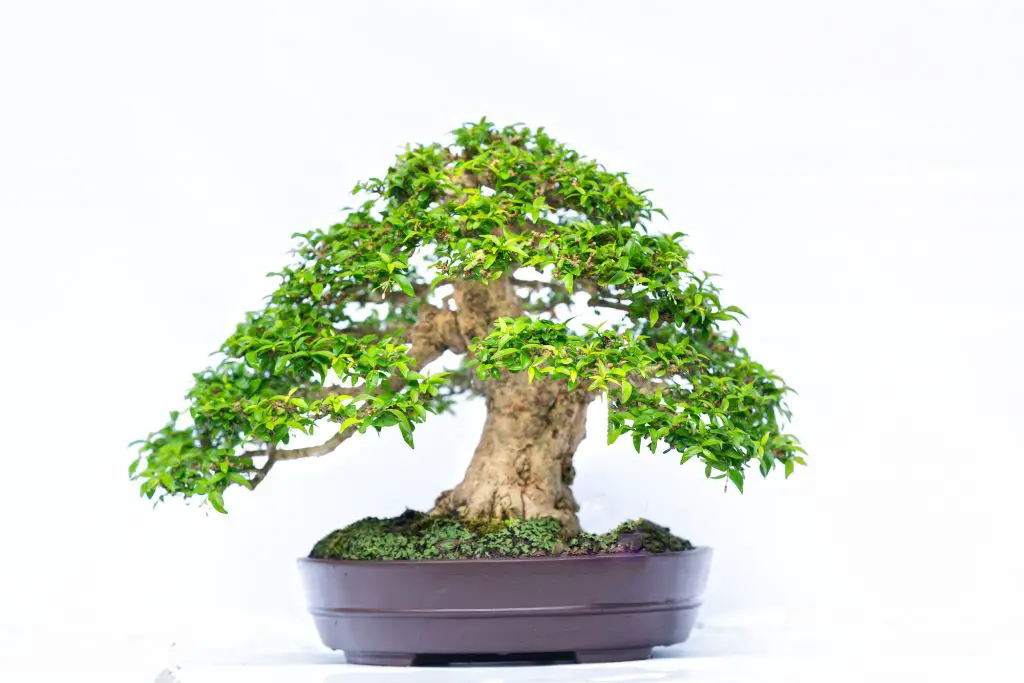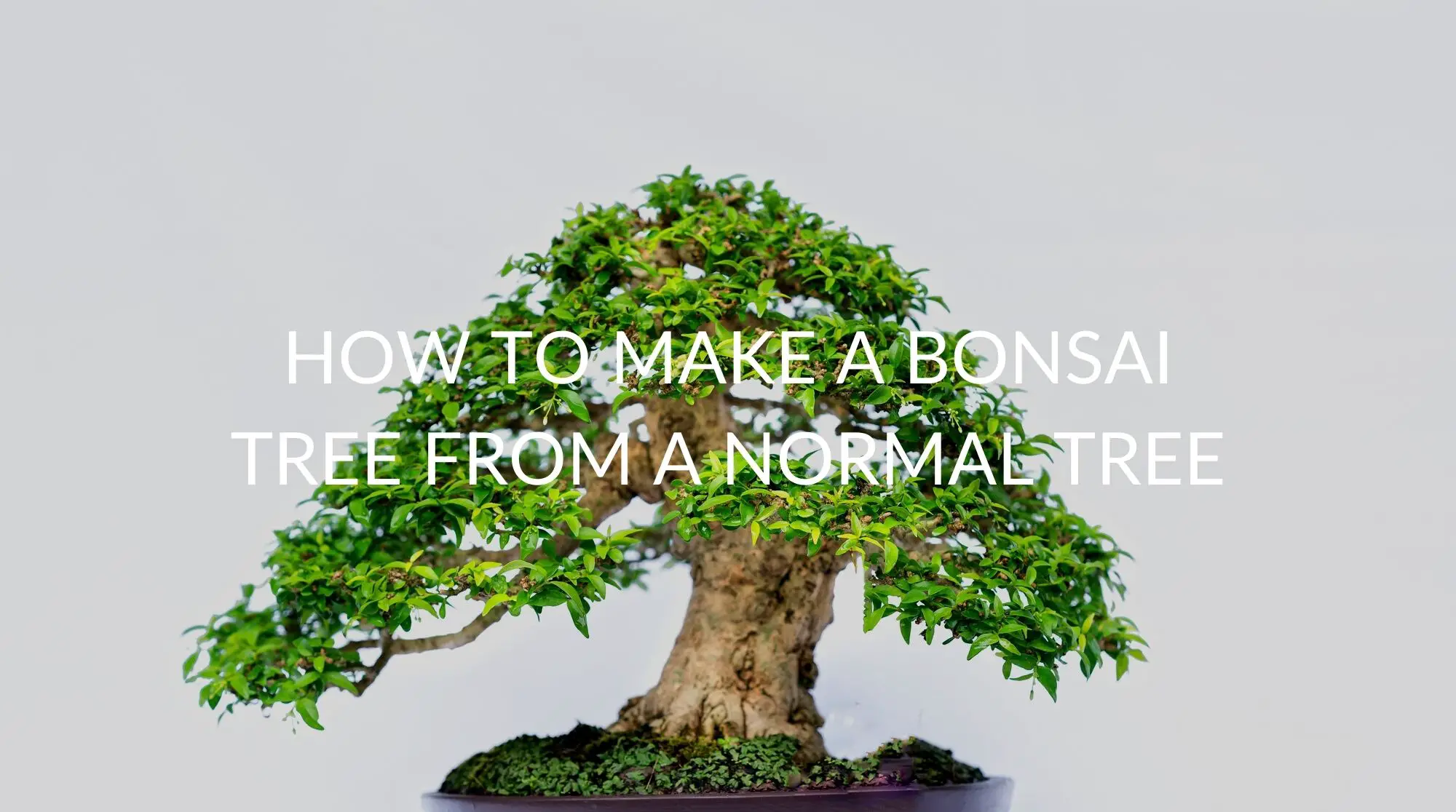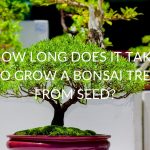You may be wondering if it is even possible to grow a Bonsai tree from a regular tree. The answer is yes–with some patience, practice, and skill, you can grow your own Bonsai.
Any type of tree that has a woody stem can be made into a Bonsai (technically, “Bonsai” just means “grown in a pot”), but you will need to choose a tree that is suitable for you, your skill level, your taste, and your climate.
Read on for all the info you need to learn how to make a regular tree into a Bonsai tree.
Can You Make A Bonsai Tree Out Of Any Tree?
Bonsai trees are not genetically “dwarf” trees–all of them are made out of regular trees. So, technically, you can make any species of tree or shrub into a Bonsai. This will be most easily done with trees that have wooden stems.
Some Bonsai growers make Bonsai out of saplings they find in local woods or from young plants bought at garden centers or grown from seed. You can also grow a Bonsai sapling from a cutting of a larger tree.
Choosing something that grows outdoors in your local climate might be a good first step–so you know the tree will be suitable for your climate. Keep in mind that evergreen and deciduous Bonsai generally need to be grown outdoors (but possibly protected from hard frost).
Subtropical Bonsai species will not be able to tolerate cold temperatures and will need to be grown indoors in winter if you live in a cold climate.
Can You Make A Bonsai Tree At Home?
Yes! The most important thing to consider when getting started is whether your species of tree will thrive in your home environment. You can find information about tree species here.
Make sure you have a place to keep your Bonsai that has the right conditions for your type of tree. Check what amount of light each species of tree will need (many Bonsai require a lot of light) and also what temperature ranges it can tolerate.
If you have a tree that is already growing well in its location and conditions, that might be a good tree to start with when making a Bonsai.
It will need to be kept in the same conditions as a Bonsai as it was as a normal tree, for the most part. Because it will be kept in a small pot, it may require more frequent watering and protection from frost.
All you will need to get started making a Bonsai tree are some tools, a tree, some soil, and a pot. (And maybe a little confidence.)

How To Make A Bonsai Tree From A Normal Tree
If you already have a sapling or small tree at home, here are the steps you will take to make it into a Bonsai tree. This is best done in early spring.
You will need a tree, a Bonsai pot, Bonsai soil, wire, wire cutters, a chopstick, and concave cutters (or pruning shears).
Trim Dead Branches and Foliage.
You will want to trim away any yellow or brown leaves or needles and cut dead branches. Make sure you look inside the foliage and trim anything on the interior. Pull away the branches and look at the shape of the trunk. This will give you an idea of the shape of the healthy plant.
You will also want to remove the tree from its pot and brush away the top layer of soil so you can see the roots. These steps allow you to see the shape of your tree so you can determine what side the front of it should be.
Start Pruning.
A general rule of thumb is that branches begin around ⅓ of the way up the trunk, but as with all style rules, it is up to you!
Some designers like to cut away branches in front of the trunk so the shape and angle of the trunk can be seen. Many also trim away any branches that have an upward or downward slant. Again, all of this is up to you.
You may even try to look at a picture of your favorite Bonsai to get a sense of what design looks good to you. Generally, Bonsai trees taper toward the top. The best-looking Bonsai tend to have a nice crown at the top.
Keep in mind that you will probably be placing wires on the trunk and branches of the tree, so you may want to trim away anything that might get in the way of the wires. This will come with practice.
You can safely cut away up to ⅓ of the existing tree without damaging the tree. Be careful not to cut away so much that the tree cannot survive. (You can prune more later as needed.)
Prepare Your Pot.
Keep in mind that you can leave your Bonsai in the pot it is already in for a year and come back to repot at the beginning of the next spring. This will keep the tree from experiencing the additional stress of being repotted after just being pruned and shaped.
That said, if you want to place your tree in its new pot right away, you will need to select a low pot with good drainage holes that you can fit wires through. You can find more information about selecting a pot here.
Bonsai pots can be made of a variety of materials, though ceramic pots with enamel tend to be the most common. Typically Bonsai pots have “feet,” though any pot with adequate drainage will work for Bonsai.
First, you will need to place mesh over the drainage holes, so your soil doesn’t come out through the holes. You may want to anchor the mesh to the bottom of the pot with wire.
If your pot has two holes, place a long wire through the two holes and back up into the pot. This will wrap around the trunk of your tree and anchor it to the pot, so make sure you have long enough wires to wrap the trunk of your tree (you can always trim them later).
Prepare Your Tree.
Carefully remove your tree from its pot or from the ground if you are harvesting a sapling. Try not to damage any roots. If you are removing a sapling from the ground, try to retain all the roots.
Carefully tease out the roots, using the chopstick to brush away the dirt. Start at the bottom and work your way up to the trunk. Cut away any roots that don’t look healthy. This would be anything black or brown, or that has a foul odor.
Then, you will want to trim away any roots that will not fit into your small pot. You can safely remove up to ⅓ of the roots and still keep the tree healthy.
Wire your Tree into the Pot.
Keep in mind that it is essential that you use sandy, well-draining soil to grow Bonsai. Many garden centers sell premixed Bonsai soil, which should be adequate for many types of Bonsai trees.
You can find additional information about Bonsai soil here. Different species of Bonsai may require slightly different mixtures of soil.
Add a thin layer of soil to the bottom of the pot. Then place your tree in the desired position in your pot. You may want to place it slightly off-center. Remember that you chose a certain side to be the front.
Anchor the trunk of the tree with the wire by placing the wires through the root ball. Then wrap wires around the trunk, gently shaping it as desired. You can prune any additional branches as needed to wire your trunk.
Wire the Branches into the Desired Style.
Starting at the bottom, wire the branches into your desired Bonsai shape. You may need to wire branches together in order to create space between branches.
If branches feel unstable, you can wire them to the trunk as well.
Make sure your wire is strong enough to hold your branches in place. Typically Bonsai are wired with either copper or aluminum wire. Ask at a garden store to see both kinds of wire so you can get a sense of what might work best for your tree and what is easiest for you to work with.
You can find additional guidance on Bonsai wire here.
After the tree is placed in the pot and wired the way you want it, add soil on top of the roots. Gently push it down with your fingertips or the chopstick, so no air bubbles or pockets are left.
Water Your Tree and Keep it in Shade.
You will need to saturate your tree on its first watering (or anytime the soil has gotten very dry). Make sure you are soaking it evenly and that it is in a place where it can fully drain.
A tree is watered thoroughly when no more air bubbles rise to the surface.
Make sure you keep your Bonsai in the shade for around a month after potting. After a month or so, gradually move it into ideal lighting conditions. This will vary depending on the species of your Bonsai. It is imperative that you know how much light your tree will require.
If you do not have enough natural light available, you can look into grow lights.
Remove the Wires after Three or Four Months.
After a tree is wired into shape, it takes a few months for the trunk and branches to hold the shape. Keep an eye on your tree during this time, however, to make sure the wires aren’t so tight that they are cutting into the bark or wood of the tree.
Remember that many young Bonsai need to be repotted every other year or so. Make sure you familiarize yourself with what conditions your species of tree needs.
How To Turn A Large Tree Into A Bonsai
There are two ways to turn a large tree into a Bonsai. Large deciduous trees (such as a Ficus) can be cut all the way back to a stump. From the thick stump, new branches will grow. As time passes, you will be able to shape these branches into the desired look of your tree.
You can also take a larger tree, cut it back slightly, and make it into a larger-sized Bonsai, which will be planted in a Bonsai pot around one foot in diameter. Large Bonsai trees are typically between 2.5 and 5 feet tall.
If you are digging a tree out of the ground, try to maintain as much of the root structure as you can so you have a lot to work with. You can cut the taproot, but leave as many of the smaller roots as you can.
The steps to making a large tree into a Bonsai are similar to those above.
Decide What Side of your Tree is the Front.
Since larger trees will have thicker, more established trunks, you will probably be making the trunk of the tree a focal point. Make sure you like the taper and shape of the trunk.
You may want to trim away any extra branches that cover your trunk, are too low on the tree, or that may be too long to be in proportion to your tree.
Make sure you trim away any dead foliage or branches at this point as well.
Wire the Tree into your Desired Style.
Leaving the tree in its current pot for stability, wire the branches first. Since this tree’s trunk is already established, it probably won’t need as much wiring as a smaller tree.
Branches that are too large to be wired will need to be removed or fit into the larger design of your tree. Keep in mind that you may need to use a larger gauge wire for more established trees. Some growers use a variety of gauges of wire on one tree, depending on the size of each branch being wired.
Since a larger tree will have a more established trunk, you can anchor the branches down to the trunk as a way to shape your branches into a nice downward curve.
Prepare your Tree Roots.
If a tree has been growing in a large pot (like a flower pot), it may take a little work to untangle the roots. You will probably need a stronger tool than a chopstick for larger roots. A hand rake may work best.
Remove extra dirt (especially if your tree was growing in potting soil) and trim extra roots. Some roots may be curled around the pot and will need to be trimmed. Try to make sure your roots grow radially out from the trunk.
If your roots are very tightly compacted, this may take quite a bit of scraping, but it will be worth it!
Prepare your Pot.
As with smaller Bonsai, you can leave a tree in its pot for a year and repot it the following spring to protect the tree from too much stress. With more established trees, this may not be as much of a problem, though it is something to keep in mind.
Choose a pot with excellent drainage. For a large pot, there should be multiple drainage holes. Place wire through the holes, going up into the pot.
Place a layer of Bonsai soil or drainage material in the bottom of the pot, and then place your tree in the pot as desired. You can wire it gently into the pot, so it stays while you fill in the rest of the pot with soil.
Since larger trees may have large root masses, you may want to keep some of the roots visible above the soil as a visual detail.
Make sure you water your tree thoroughly after potting.
Find a Good Location.
Location, location, location. Make sure you know what species of tree you have and can place it somewhere it receives enough light and is in the correct temperature range for its species.
If you were growing it in a flower pot, you could return it to the same location, though it may need additional water since it will be growing in a smaller pot.
Larger, more established Bonsai trees do not need to be repotted as frequently as younger, smaller trees.
You can find information on Bonsai species here.
Bonsai Care Tips
Now you have a Bonsai you designed yourself! You will want to make sure you give your tree the care it deserves. Here are some general Bonsai growing tips.
Know your Species
Evergreen (Juniper, Pine, Cedar, Spruce, Fir) and deciduous (Chinese Elm, Japanese Maple) Bonsai typically need to be grown outdoors year-round. Subtropical species (Ficus, Jade) can be grown outdoors in warm climates but typically need to be protected from cold or cool temperatures.
Get the Right Light
Many Bonsais need a very bright light or full sun. Indoor Bonsai may not receive enough light, especially in the winter months.
Water your Bonsai Correctly
There is no set schedule for watering Bonsai. A rule of thumb is to water your tree when the top of the soil is dry. The only way to determine this is to check your tree regularly! Remember that water needs will vary with the temperature, season, length of the day, and humidity, so you will need to monitor your tree year-round.
If you are going out of town, ask a friend to water your tree! Some Bonsai may need daily watering if they are in very small pots in dry climates.
Don’t overwater, either. Make sure your tree is in Bonsai soil in a pot with adequate drainage. If the leaves are turning brown or yellow, it could mean you are overwatering or underwatering your tree.
Fertilize your Tree
After your tree has gotten used to its new pot for a few months, you may want to fertilize. Typically this is only done in the spring and summer growing season.
You can find additional Bonsai resources here.
FAQ
Can You Grow A Bonsai Tree From A Regular Seed?
Yes! The biggest trick to growing Bonsai from seed is having the patience to watch them grow. Keep in mind it will take several years for your tree to get big enough to shape your tree into a Bonsai. The benefit of growing from seed is that you have cultivated the tree from start to finish.
If you are growing trees from seed, it’s a good idea to plant several seeds, so you have a variety of saplings to choose from.
Can You Grow A Bonsai Tree From A Cutting?
A slightly quicker way to create your own Bonsai is to use a cutting from an existing tree. You will need to take a cutting of a branch at a 45-degree angle. Plant the cutting around one inch deep in Bonsai soil and keep it watered.
Cuttings will take a few years to grow into saplings ready to be shaped. Like with seeds, it’s a good idea to start with several cuttings in case some don’t make it.
Conclusion
Styling a Bonsai tree from an existing tree is a challenge, though it is gratifying to know you designed your tree exactly as you wanted it.
Bonsai styling is a skill, however, and it may take several tries before you get it right. If you want to make a Bonsai of your own but don’t know where to start, look into taking a Bonsai class to help you learn the basics.







